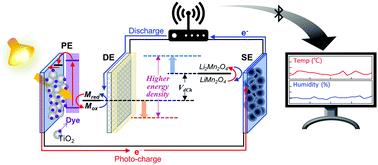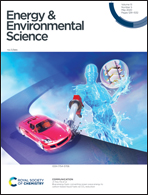Indoor-light-energy-harvesting dye-sensitized photo-rechargeable battery†
Abstract
Photo-rechargeable batteries (PRBs) benefit from their bifunctionality covering energy harvesting and storage. However, dim-light performances of the PRBs for indoor applications have not been reported. Herein, we present an external-power-free single-structured PRB named a dye-sensitized photo-rechargeable battery (DSPB) with an outstanding light-to-charge energy efficiency (ηoverall) of 11.5% under the dim light condition. This unprecedented ηoverall was attributed to the thermodynamically-favorable design of the DSPB that maximizes the working potential. At high-power irradiation, the kinetically-fast but thermodynamically-unfavorable iodine mediator (I−/I3−) showed the highest charge and discharge capacities even if its discharge voltage was lowest. Under dim-light for indoor applications, however, the thermodynamically-favorable but kinetically-slow copper complex mediator (Cu+/2+(dmp)2) showed energy density and efficiency superior to I−/I3− because its kinetics did not limit the harvesting capacity. The successful demonstration of the ability of the DSPB to operate a temperature-sensing IoT device only by indoor light opens the possibility of realizing indoor-light-harvesting PRBs.

- This article is part of the themed collection: Energy & Environmental Science Cover Art


 Please wait while we load your content...
Please wait while we load your content...